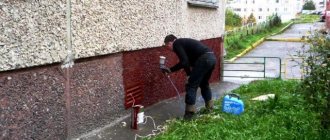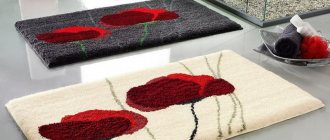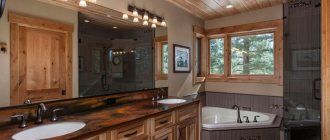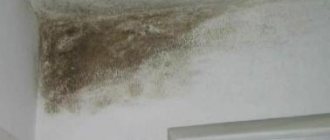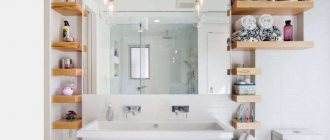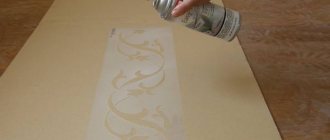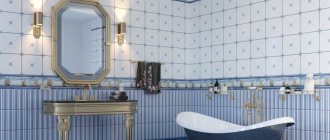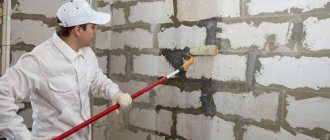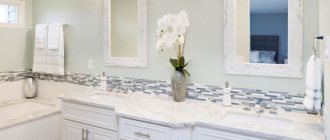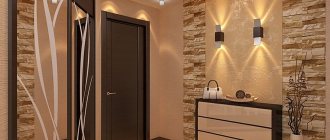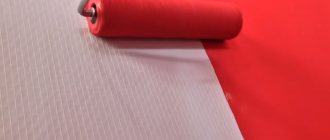Pros and cons of painting walls
Finishing walls with paint is a cheaper option compared to tiles, plastic panels or decorative plasters, but has no worse properties.
The positive characteristics of painting walls are:
- Budget savings. Paints are cheaper in price than other types of finishes, so painting your bathroom won't break your budget as much.
- Easy to apply. Coloring is done easily and without any special skills.
- Assortment of colors. The variety of palettes can bring any designer's ideas to life.
In addition to the listed advantages, it is worth adding that good paint, when applied correctly, will create a room that will meet sanitary hygiene standards.
Negative qualities of the painted surface include:
- Frequent cleaning. Every day after bathing, the walls must be wiped.
- Condensate. It occurs when a small bathroom has poor ventilation and therefore destroys the finish. In this case, you often have to renovate the bathroom.
- High probability of damage to the coating. You can easily scratch it with a sharp object, ruining the finish, and moisture will collect underneath it.
Types of paints
The bathroom is a room where humidity is high. When choosing a type of paint, it is necessary that it has the following properties:
- resistance to humid air;
- let air through;
- antibacterial protection;
- without toxic substances in the composition.
In the modern construction market, depending on the base in the composition, there are the following types of paints:
- Oily. The low price of this type, coupled with a long service life, makes them a common material among repairmen. After painting, a durable layer is created on the walls.
- Alkyd. They have high water-repellent properties, so they are often used for bathroom renovations. They can be glossy or matte and are toxic during application.
- Aquatic. Paints based on this type are considered by professionals to be the best solution for painting a bathroom. They have a high degree of resistance to moisture and ultraviolet radiation. After application they dry quickly. The walls are allowed to “breathe”.
Depending on the composition, there are the following types of paints:
- Acrylic. They are universal and fit equally well on any surface, regardless of its material.
- Mineral. They can be applied to any surface, but have a short service life.
- Silicone. Such paints are strong and durable, but very expensive.
- Silicate. They have a high degree of vapor permeability, are resistant to temperature changes and precipitation, their service life can be 20 years.
What paint can you paint bathroom walls with?
Since the bathroom is a place with high humidity, the dye must have moisture-resistant qualities, and at the same time antibacterial resistance.
It is best to purchase paint from a series of water-dispersed ones based on acrylic or latex, but there are a number of other coatings, let’s figure out which ones.
Water-dispersion paint
The composition of water-dispersion paint is different from the composition of water-based emulsion. In it, the list of components includes polymers and aqueous dispersions, the binder component is represented by acrylic and vinyl acetate polymers.
The drying speed is excellent; after 2 hours from the start of work, the coating will be completely dry.
If the room is warm and the air temperature is 18-22 °C, then you will have to wait even less for drying - half an hour.
The paint will last a long time, is vapor-permeable, easy to clean and resistant to detergents. The coating does not emit any odor during work, and adhesion is also excellent.
Alkyd enamel
Enamel solutions have a varnish in their composition. The most popular choice is alkyd resin paint. This composition is notable for its drying: it is not the evaporation of the solvent that works here, but the oxidation of the alkyd enamel, which reacts with air.
If you want to paint your bathroom with vapor-permeable compounds, then alkyd enamel does not belong to this type.
The paint is ready for use immediately after opening the container and can be used on any surface, even metal. Enamel requires a special solvent.
The disadvantage is easily considered the spread of an unpleasant odor throughout the room, which is not particularly welcome in the confined space of a bathroom.
Water-based paint
There are several main coloring compositions that are classified as water-based:
- Acrylic;
- Silicone;
- Latex.
The advantage of water-based emulsions is that they can simply be diluted with water and easily washed off from everywhere, without any special effort. The painted surface dries quickly due to the fact that the solvent is water.
There is no doubt about the safety of the paint, it’s nice that there is no nasty smell. The compositions are suitable for various surfaces, except metal.
Acrylic
Acrylic paint is optimal for painting bathroom walls. The benefits of the purchase are explained by the large color palette, resistance to dirt, and simplicity of the painting process.
The smell is quite light, not pungent, so you can avoid unpleasant sensations when painting the walls in your favorite bathroom. Good acrylic paint contains antifungal additives, which increases the attractiveness of the product.
Alkyd paint can cover walls that are constantly in contact with moisture.
The viscosity of the composition is such that it can easily hide small imperfections on the surface of the bathroom walls, which do not need to be prepared for the painting process.
Latex
Latex paint also has advantages and disadvantages. If we first talk about the disadvantages, then this is the addition of antifungal components. Because of this, there is a need to pre-treat the bathroom walls with some antiseptic composition. Also, walls painted with latex paint do not withstand low temperatures well, although in a bathroom this minus is hardly relevant.
Sunlight does not favor latex-painted walls, causing the surface to fade and fade.
Now about the positives. The surface after coating is elastic, which will hide minor imperfections in the surface, hiding small chips and cracks underneath. The coating is durable, resistant to mechanical damage and stress.
The paint does not emit a specific odor and does a good job of protecting walls from dirt, which makes the composition universal.
Latex paints take about two hours to dry.
Silicone
Silicone and silicate bases are popular due to their physical characteristics. These are compositions that in no way can allow water to pass through and are resistant to various types of contamination due to the resulting vapor-permeable coating.
But PVA-based silicone water-based paint is not recommended for use for painting bathroom walls. But you can use the dye for the ceiling in the same room.
Textured paint
Textured paint should be classified as water-soluble, which means that the solvent is water. You cannot be overzealous and dilute them with water, they will become completely liquid, and the decorative effect will be negated.
The result is a relief wall, minor defects of which will be hidden by a layer of paint. However, errors greater than 4 mm will remain noticeable.
If the painting technology is followed, the coating will remain beautiful and durable for many years, and will not fade in the sun if there is a window in the bathroom. Moisture and temperature changes are also resistant to this coating.
The consumption of textured paints is always high, and the cost also does not fit into the category of low and cheap compositions. To apply the composition perfectly, you need skill.
Oil paint
Oil paints are familiar to everyone, since previously there was no such chemical variety on the shelves: they used to paint everything that could be painted.
Oil-based compositions take longer to dry than others, the paint must “set”, only then the unpleasant odor disappears. Today, such paints are used for painting facades, fences, metal, and wood products.
Nowadays, when water-dispersion paints are mainly used for interior decoration, oil-based analogues are intended for exterior work or painting materials such as metal or wood
The composition is classified as high-strength, which is very attractive for the bathroom. But a specific smell during work cannot be avoided, and the coating takes a very long time to dry.
Chlorinated rubber
An excellent option for finishing a bathroom. This paint can be used to replace mosaics and ceramic tiles. The coating does not need to be updated frequently; it remains beautiful for a long time.
The advantages of the chlorinated rubber composition are numerous: they are moisture resistant, they do not care about contact with water, and the sun’s rays with ultraviolet radiation will not damage the walls.
If you buy such paint to improve the design of the bathroom, then you should take into account the need for high-quality preparation of the walls for painting. The dye can be successfully used on cement coating and metal, without pre-treatment with putty and primer. The old coating must be removed.
The price of painting a bathroom with chlorinated rubber dye is substantial, since at least three layers are applied. Solvents are also needed, not ordinary ones, but specially designed ones. The result is always impressive, and the costs no longer seem significant.
Design and its secrets
The design of painting the walls in the bathroom is a very important issue that must be decided before finishing begins.
The first step is to decide on the color of the coating. There are some secrets to choosing the right tone for your room. They consist of the following criteria:
- If the bathroom is small, you need to buy light-colored paint, it will visually increase the space. Peach, pink, blue, white and green color shades are ideal.
- It is better not to paint a small room completely, but to combine it with tiles or plastic panels.
- A large and spacious bathroom is a good room for experimenting with the most daring ideas, in which rich colors play an important role.
The texture of the paint is also of no small importance when choosing. It comes in two types – matte and glossy. Paint with a matte texture is universal and, after application, hides minor surface imperfections. The glossy texture will add shine and richness of color to your bathroom design.
Gloss looks beautiful only on perfectly smooth walls.
Common mistakes: how to avoid
There is no need to make your own mistakes when you have advice from experienced specialists. Save your time and mental strength!
- Don't forget about ventilation No matter how good the paint is, it is still a product of chemical production. In addition, in a ventilated room the drying process occurs much faster.
- It’s a good idea to make sure that the paint you choose is suitable for painting the walls in the bathroom. The label will provide this information.
- We give preference to a composition marked “washable paint”.
- Painting always starts from corners and hard-to-reach places.
Preparing the walls
Preparing bathroom walls for painting is a very important step before applying the finishing material. It consists of the following points:
- Dismantling the old finishing coating.
- Cleaning walls from dust and dirt.
- Sealing cracks and holes.
- Primer of walls.
- Putty the surface for maximum leveling.
- Sanding putty walls with sandpaper.
- Treat with a primer with antibacterial properties, at least 2 times.
Before applying a new layer of any solution, you need to let the previous one dry.
Painting tools
Painting your bathroom yourself is not a difficult job. The main thing is to have the necessary tool at hand.
You can paint the walls with the following tools:
- Brush. Thanks to her work, the texture is dense, but the material consumption is too high.
- Roller. It applies a thin layer of paint to the surface, which saves paint consumption, but it is inconvenient to paint corners with it.
- Spray. They are very convenient for quickly painting walls. Not everyone has it, so it doesn’t make sense to buy it just to renovate the bathroom once.
When painting, it is better to use a roller and a brush: such a pair of tools will cope with the repair without any problems.
Purchase of necessary materials and tools
Each material has instructions on how to use it. This allows a person who has never done repairs to quickly navigate the features of a particular paint, plaster, or putty. For the bathroom, as it belongs to rooms with high humidity, it is necessary to choose materials marked “moisture resistant”. The second place in choosing paint will be its color, the first - the characteristics of the material.
“Waterproof” - when you see such a mark, it is better to leave this material on the store shelf. It is more suitable for external work, and in the bathroom it will create a greenhouse effect - condensation will accumulate on the surface of the walls. We can immediately make a reservation that this type of finishing materials includes oil paints. Despite the fact that builders still often use them to decorate the walls of bathrooms in new buildings, it is better to choose latex, acrylic or water-based ones.
The color of modern paints is brighter, and there are much more shades. Bathroom design will only benefit from this. The choice of oil paint in most cases is based on lower cost over latex and acrylic.
There is no clear answer to the question of what paint to use in the bathroom; the main thing is that the coating is even and lasts a long time. All materials have strengths and weaknesses. When conceiving a design with subsequent drawing, it is better to choose acrylic. To obtain a thin, bright coating, latex is more suitable. For DIY repairs, both types of paints are good.
Related article: Toilet design 2019-2019: modern bathroom design ideas
How much paint to take for a bathroom renovation can be determined by the instructions on the can. Knowing the footage of the room and multiplying it by the height of painting, the result will be how many meters need to be painted. By comparing with the data on the packaging, you will be able to decide whether one container is enough or several are needed. All that remains is to choose the paint color.
Dyeing process
After preparing the bathroom walls for painting, you can directly begin finishing.
The easiest and fastest way is to paint the walls one color. Areas that do not need to be painted must be sealed with construction tape.
Painting the walls is done step by step:
- Mix the paint until smooth. Carefully remove all formed lumps.
- .If we paint with water-based paint and not white, then add color to it, stirring, gradually pouring in a thin stream until the required shade is obtained. Oil paints and enamels are sold already mixed.
- First of all, carefully paint all the corners with a thin brush.
- Take a roller or a wide brush and start painting all the walls, starting from the top. We dip the tool into the paint lightly so that no smudges form on the surface. Having finished painting the entire coating, wait for it to dry.
- After drying, apply another layer of paint, repeating the previous maneuvers.
If after two layers of material the tone of the walls is not yet uniform, it is necessary to paint the surface a third time.
On video: the pros and cons of painting bathroom walls.
Features of waterproof paints
Acrylic waterproof is presented in a large assortment, which will allow you to create a completely original design using pure, rich color. True, this type of paint can only be used on perfectly leveled walls. It is not very expensive, and when compared with ceramic tiles, its price is generally ridiculous.
If the radiator in the bathroom is replaced with a shiny heated towel rail, then one problem disappears by itself.
If there is still a metal radiator in the bathroom, then you need to choose a contrasting or matching shade with the one used for the walls, otherwise the design may suffer. You cannot paint batteries with acrylic paint, like other metal surfaces.
For walls, this material is ideal, especially when creating a textured pattern or color transitions created with an almost dry brush. You can use the white color of the walls as a background, which is obtained by using a decorative primer. Or you can combine two contrasting or shading shades of acrylic paint with the same markings. The first layer is applied with a roller, creating a flat surface; on the dried surface, using a brush with very little paint on it, apply random strokes.
When working with acrylic paint, you can give free rein to your imagination. Textured bumps can be obtained by applying the material to the walls with a roller with a long soft pile. This is very easy to do with your own hands, you just need to make sure that there is enough paint on the roller, but does not flow down when the roller comes into contact with the wall. The material consumption will be large, but the result is worth it.
Acrylic dries quickly, which allows you to not only apply a layer of paint on the wall in one day, but also decorate it with a stencil design.
Not everyone can make a stencil with their own hands, but everyone can apply a design to the wall using a rubber roller. A roller with a suitable pattern can be purchased in the same department as a regular paint roller.
Related article: Design of a small bathroom 5 sq. m: design tips (+37 photos)
Latex coatings
Latex paint perfectly creates a protective coating for walls, preventing the formation of fungus, just like any moisture-resistant paint. Unlike waterproof, it has the advantage that it allows steam to pass through, which reduces the formation of droplets. With a small difference in temperature between water and air, with little steam formation, condensation does not form at all, which makes washing the walls less frequent due to the absence of water stains.
When directly interacting with water, the latex coating does not lose its appearance and does not collapse. Small cracks in the wall will not become an obstacle to painting, without preliminary putty, due to the thickness and ductility of the paint.
Water emulsion
Water-based paint is an excellent moisture-resistant material. Most often on store shelves you can find water-based emulsion that is pure white or with a tint of ivory. It can be used to cover walls in the bathroom, with the exception of those areas that are located directly behind the sink, shower stall, or bathtub. Ingress of foam, toothpaste and other detergents that are not dangerous to humans can damage the paint coating.
There is no question of washing off soap stains from the surface of the walls using abrasives. This paint is cheaper than others, but the difficulty in maintaining it makes its use inconvenient.
Painting methods
Bathroom decor in modern times can be both creative and unique. There are several options for painting walls for bathroom decor:
- Drawings using stencils. We paint the walls in the chosen color, and after drying, using a stencil we apply drawings all over the wall.
- Stripes using tape. We cover the walls with strips, leaving the desired gaps open for painting. The number of colors and its shades depends on personal imagination. Remove the tape from the surface slowly, preferably after the paint has dried.
- Making patterns using rollers. At a building materials store we purchase a patterned roller, which consists of a foam roller and an additional one with an engraved pattern. On the walls that are painted with the main color, we begin to apply patterns with a roller. For the pattern, select a color that matches the base color or matches the shade. While applying the pattern, the roller must be kept level and painted from top to bottom vertically.
During repairs, the room must have good ventilation so that the finish dries on time, because the air in it is high in humidity. Drafts must be excluded, and the temperature should be within 20-25 degrees, without sudden changes.
Decorative painting
You can give in to the creativity playing in the shower and try to paint the bathroom walls in an original way.
Stripes and other shapes
To depict geometric patterns, use masking tape. It is easy to apply and also easy to remove after finishing work.
The tape is pasted where they want to get a pattern and even borders. Thanks to this technique, the walls cease to be monotonous and monotonous. The tape is removed after the applied layer of paint has dried.
Stencils and drawings
Applying a design using a stencil is easy and interesting. You will need a ready-made stencil and a painting tool.
This is what it looks like in the photo:
Pattern rollers
The most pleasant way to work: ready-made rollers are sold, with patterns already applied to them. Dip the roller in paint, remove the excess and run it over the wall.
More ways to decorate walls:
Painting mistakes
Even after studying the manual and recommendations of wall painting experts, many make mistakes. Because of them, you can renew the walls in the bathroom within a year.
The most common mistakes when painting a surface are:
- Painting walls without prior preparation. Even if the walls seem smooth and clean, they still need to be prepared. How to prepare walls for painting is described above.
- No primer. Often, most people think that priming walls is unnecessary because the walls are clean. Over time, due to the lack of a primer layer, fungus appears and the paint peels off from the surface.
- The paint was not prepared correctly. Before preparing a paint solution, you must carefully read the preparation instructions. The prepared mixture should be neither thick nor liquid, but of medium consistency, without lumps.
- Indiscriminate application of finishing material. The method of painting is very important; the type of coating after drying depends on it. Movements when painting should be directed in one direction and be either vertical or horizontal. Chaotic movements after drying are visible.
It is better to apply the next layer of paint perpendicular to the previous one, then the dried walls will be well covered.
- Violation of the drying time. On the paint packaging, each manufacturer indicates the drying time of the layers. Even if the finish seems dry to the touch, it is better to wait the specified hour so that when applying the second layer, the first does not end up on the roller.
Recommendations from professionals
To eliminate any defects after the finish has dried, you need to listen to the recommendations of specialists:
- Do not touch the paint while it is drying;
- Never apply a second coat if the first is not yet dry;
- Carry out coloring in daylight; electric light does not allow you to see the mistakes made;
- If paint gets on the floor, remove stains before they dry.
Painting the walls in the bathroom yourself is not so difficult, the main thing is to follow the instructions, adhering to the sequence of steps.

